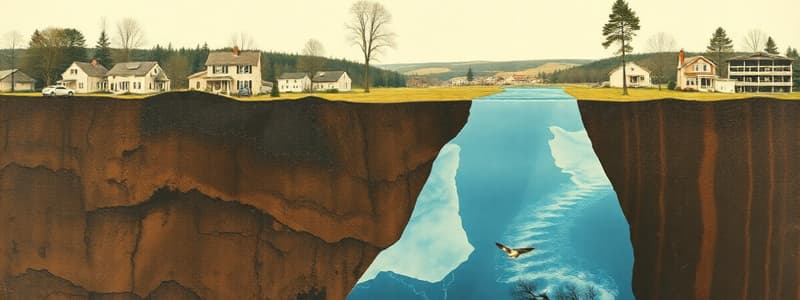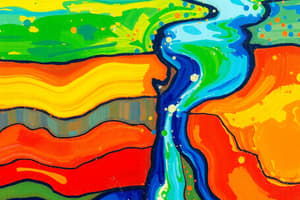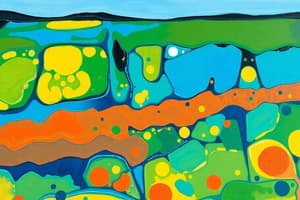Podcast
Questions and Answers
What is the process called by which precipitation moves into the ground and becomes groundwater?
What is the process called by which precipitation moves into the ground and becomes groundwater?
- Aquiclude
- Permeability
- Evaporation
- Infiltration (correct)
What defines the upper boundary of the zone of saturation?
What defines the upper boundary of the zone of saturation?
- Aquifer
- Zone of aeration
- Water table (correct)
- Aquiclude
What is the main characteristic of an aquifer?
What is the main characteristic of an aquifer?
- It is a completely impermeable layer.
- It is found above the water table.
- It contains saturated groundwater. (correct)
- It prevents water flow.
Where do springs typically emerge from?
Where do springs typically emerge from?
What is a geyser known for?
What is a geyser known for?
How does a water-table well function?
How does a water-table well function?
Which term refers to a layer that acts as a barrier to groundwater flow?
Which term refers to a layer that acts as a barrier to groundwater flow?
What does permeability refer to in the context of groundwater?
What does permeability refer to in the context of groundwater?
Flashcards
Infiltration
Infiltration
The process by which precipitation that has fallen on land moves into the ground and becomes groundwater.
Zone of Saturation
Zone of Saturation
The region below Earth's surface in which groundwater completely fills all the pores of a material.
Water Table
Water Table
The upper boundary of the zone of saturation.
Permeability
Permeability
Signup and view all the flashcards
Aquifer
Aquifer
Signup and view all the flashcards
Aquicludes
Aquicludes
Signup and view all the flashcards
Spring
Spring
Signup and view all the flashcards
Geyser
Geyser
Signup and view all the flashcards
Study Notes
Groundwater
- Groundwater is water found underground in the cracks and spaces in soil, sand and rock.
- A region completely filled with water is called the zone of saturation.
- The upper boundary of the zone of saturation is the water table.
- The depth of the water table varies based on precipitation and other weather conditions.
- Above the water table is the zone of aeration, where materials are moist but not saturated with water.
- Water moves through the ground due to permeability, the ability of a material to let water pass through.
- An aquifer is a permeable layer of subsurface material that's saturated with water.
- Impermeable layers are called aquicludes; they block groundwater flow.
Groundwater Movement
- Groundwater flows from areas of high pressure to areas of low pressure.
- Precipitation and infiltration are important factors in groundwater supply.
Springs
- Springs are areas where groundwater emerges naturally from the ground.
- Springs can form at the edges of valleys, perched water tables, along fault lines, and underground pathways.
- Hot springs emerge from sources that are hotter than the average annual temperature.
- Geysers are eruptive hot springs that occur when water is superheated and vaporizes, building up pressure and resulting in eruptions.
Wells
- Wells are holes dug or drilled into the ground to reach an aquifer.
- Water-table wells are the simplest type, and the water level in the well matches the water table level.
- Artesian wells tap into pressurized water in a confined aquifer.
Protecting Groundwater
- Pollution can enter groundwater through runoff, infiltration, or direct contamination.
- Sometimes polluted groundwater must be pumped out for treatment.
- Humans should be aware of how their actions impact the groundwater system.
Groundwater Erosion
- Groundwater is slightly acidic due to carbonic acid.
- This acidity can dissolve limestone over time.
- Caves are underground openings formed by dissolving rock by the action of groundwater.
- Sinkholes form when caves collapse.
Groundwater Deposition
- Dripstones are rock formations formed by water dripping through caves.
- Stalactites hang from cave ceilings and stalagmites rise from the cave floor.
Studying That Suits You
Use AI to generate personalized quizzes and flashcards to suit your learning preferences.




